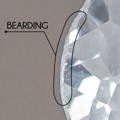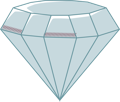Your Cart is Empty
What you should know about diamond imperfections
the secret life of diamonds
When you think of a diamond, do you picture a flawlessly shiny, round stone with a breathtaking sparkle? Sure, that’s the classic image: the brilliant cut, Tiffany-style poster child. But there’s a whole world beyond the textbook-perfect. Enter the imperfect diamond. A diamond imperfection can mean black carbon specks, cloudy areas, galaxy-like inclusions, or that signature salt and pepper diamond look. Diamond imperfection meaning? It’s the marks of a life lived. The quirks that make each stone one of a kind.
If you’re looking for a unique engagement ring that's as one of a kind as your love story, you might be wondering about alternatives to diamonds.
You know sapphires and rubies are regal, but diamonds... They just have this charm.
Maybe you learned the more affordable diamonds have imperfections or inclusions. Some consider these flaws - but we don't think of them that way! They're what makes each diamond so unique. And then there’s the bold idea that you don’t have to follow tradition.
Why settle for a cookie-cutter diamond when diamonds with character, each telling its unique story, are out there?
Let's just say - we like our diamonds with a bit of character. Picture diamonds warm gray with fiery orange inclusions, bursts of galaxy-like explosions, or dark and moody with shimmering ice crystals, or even yellow with vibrant milky swirls. And no, I'm not talking about ice cream flavors!
Owning one of these unique diamonds means you've got a rare gem – literally.
So, what's the story behind these extraordinary diamonds, and why are they so special? Let’s find out.
Diamond imperfections: inclusions and blemishes
Most diamonds have flaws and imperfections, or as the experts say, "clarity characteristics". These natural features form while the diamond is taking its sweet time growing for thousands of years before being transformed into a piece of beautiful jewelry.
Most diamonds you'll find at Gardens of the Sun come with visible inclusions. Why? Because we believe in celebrating imperfections and differences. Just like that birthmark on your chin or the quirky way you laugh – it's what makes you, well, you. They’re what makes one diamond different from another. These imperfections are generally called inclusions or blemishes.
But of course, inclusions and blemishes mean different things. So let’s get to know them better.
Inclusions are found inside the diamond, sometimes extending to the surface. Ever heard of salt and pepper diamonds? That's them! "Salt" for the white or silvery inclusions and crackled clouds, and "pepper" for the dark gray or black inclusions.
Spoiler alert: salt and pepper diamonds are kinda awesome
Inclusions can reduce the value of the stones. However, how much this affects the look of the diamond depends on where in the diamond the imperfection is found. And this again, affects the price.
Blemishes, on the other hand, are surface-level. The pits and nicks that you can see and feel, depending on their size. Blemishes are external flaws, caused by wear, the cutting process or the diamond’s crystal structure.
These external imperfections can often be polished away to improve the diamond clarity and fetch a higher price. However, a diamond cutter may decide to leave the blemish to avoid losing more weight of the diamond.
Now, contrary to popular belief, diamonds don't actually shine on their own. Rather, they reflect light. The more light penetrates a diamond, the more light the diamond will reflect. And since imperfections interfere with light as it passes through the stone, they can affect how diamonds ‘sparkle’.
But here's the thing – most diamonds aren't perfect. In fact, virtually all diamonds have inclusions. Yep, even those that cost an arm and a leg. Over the millions of years diamonds are formed, they may develop what the experts call clarity characteristics. They actually help gemologists identify whether a diamond is a natural or a fake. Or sometimes even help determine where a diamond is from.
Most inclusions can only be seen through 10x magnification, so that the diamond is still considered eye-clean. How visible an inclusion is, depends on size and placement. For example, a carbon inclusion (dark color) on the middle of a diamond's table is more visible than a colorless crystal inclusion near the girdle.
Our diamonds? Many inclusions and imperfections are right up there for everyone to see, and that's okay. It's their imperfections that give them character. We choose them because of their inclusions and imperfections.
Diamond’s hardness and toughness
But it's not just about looks. Let's talk about toughness and durability. Diamonds are hard, yes, but some imperfections can make them more vulnerable. It's like a stunning vase that's a tad fragile – you just handle it with a bit more care.
Learn everything about gemstone hardness and toughness.
Diamond imperfections and durability
So, what imperfections should you cherish for their uniqueness, and which ones to watch out for?
Here's a quick rundown of what the most common diamond inclusions and blemishes look like.
types of Diamond imperfections
bearding
Inclusion
Impact on looks: low
Impact on durability: low
Also called: bearded girdle | girdle fringe | fringing
If too much pressure is applied during the polishing process, you get girdle fringes, or bearding. These are hair-like lines around the girdle.
A bearded girdle (that’s the outermost edge of the diamond) looks rough or white and fuzzy. A little like the tiny hairs of a man’s stubble or short beard.
What does this mean for you? Minimal bearding is usually not a problem, but extensive fringing is often polished away or removed by re-cutting the diamond. Unless you got yourself a very high end diamond, bearding isn’t something you should be worried about, and won’t affect the price tag on lower end diamonds.
Impact on looks is generally low, unless the girdle itself is already quite thick and you set the diamond in a prong setting. The tiny hairs can only be seen under magnification, and makes the girdle look a little rough. A bearded girdle is not visible when your diamond is set in a bezel setting.
Impact on durability is low.
Cavity or Pit
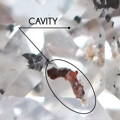

Inclusion
Impact on looks: medium to high
Impact on durability: low to medium
Also called: crevasse | indent
A small hole on the surface of the diamond. Internal inclusions close to the surface may be exposed or removed during polishing. For example a crystal can drop out when it's no longer encased inside the diamond, and forced out during the cutting process.
The cutter could have polished it off the stone, but they chose to retain the weight and optimal shape of the diamond.
What does this mean for you? Pits don’t typically impact the diamond's durability, but cavities can trap dirt and oil over time, turning it dark and more visible. If the cavity is on the pavilion, it may be difficult to clean, depending on the setting.
Impact on looks can vary from noticeable to prominent. Larger cavities may become more visible, especially if they trap dirt or oil, but they contribute to the diamond's unique character.
Impact on durability is generally minimal, but depends on the location. If the cavity is on the edge of the diamond or near the girdle, there’s a higher chance of the diamond chipping when accidentally knocked against a hard surface.

Chip
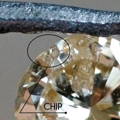

Blemish
Impact on looks: low to high
Impact on durability: low to high
Also called: nick
Minor surface damage from life's wear and tear or a hard blow after cutting and polishing. The location of the chip or nick is usually where facets meet, along edges or on the culet.
What does this mean for you? Some chips or nicks can weaken your diamond's structure over time. If it looks like it could crack further, it probably can, and another blow can make it worse. If the chip is tiny, a clever setting might just camouflage it and leave you with a diamond with a much smaller price tag.
Impact on looks depends on the location of the chip or nick, and whether the setting covers it. Small nicks can be polished out.
Impact on durability may be major, but is often fixable. Treat it gently, and it could be your little secret.
Cleavage
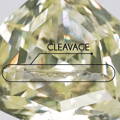

Inclusion
Impact on looks: low to high
Impact on durability: high
Not as fun as it sounds. Diamond cleavage is a straight crack with no feathering, where the diamond splits along a directional plane. People may say diamonds don't break, but in fact whether a diamond can break depends on the angle at which a diamond is hit or struck with force. Every diamond has cleavage planes, which are directions of structional weakness. Diamonds are more susceptible to splitting along those planes.
What does this mean for you? Red alert. Please leave this diamond alone. It’s not the one for you. No, really. Leave it alone.
Impact on looks is subtle to significant - small cracks you can’t see when viewing the diamond face up, don’t affect its clarity rating much.
Impact on durability is major as a cleavage can potentially split the diamond if it's hit at the wrong angle.
Cloud
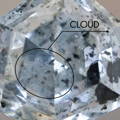
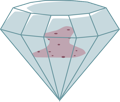
Inclusion
Impact on looks: medium
Impact on durability: none to low
Also called: group of pinpoints | pinpoint cluster | salt
Got a cloud in your diamond? No worries – it's just a cluster of teeny tiny inclusions creating patterns inside your stone. Think of it as nature's own abstract art. And the best part? It doesn't mess with your diamond's strength or durability.
What does this mean for you? Clouds generally don’t impact durability. They add unique internal patterns to your diamond.
Impact on looks can vary; some clouds look like a light haze or misty area, while others are so dense, it’s almost impossible to see through.
Impact on durability is negligible to none as clouds are internal features that don't affect the overall structural integrity of the diamond.
Crystal
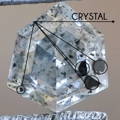

Inclusion
Impact on looks: low to high
Impact on durability: low
Think of a crystal as kind of a mini diamond within your diamond. It’s typically composed of tiny bits of diamond or mineral deposits or other gemstones, like garnet or peridot, trapped within the diamond as it formed. They sometimes look like little bubbles inside.
Crystals can be almost any size, colored or colorless, and can occur alone or in groups. Dark crystals may be referred to as carbon spots or pepper inclusions.
What does this mean for you? Crystals usually don’t affect the diamond's durability and can add a unique touch. A diamond within a diamond? Yes, please!
Impact on looks can range from barely there to strikingly visible. Smaller or colorless crystals may be barely noticeable, while larger or colored ones can be quite visible and add to the stone's character.
Impact on durability is minimal; crystal inclusions are often too small to pose a serious durability risk.
Feather
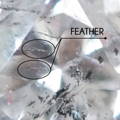

Inclusion
Impact on looks: low to high
Impact on durability: low to high
Also called: fracture | break | crack
A feather is a nice word to describe a fracture, break or crack inside of the diamond. It often looks like elongated whitish or translucent inclusion - like a hairline crack. Feathers inside diamonds are like those small cracks in vintage glass – not always a big problem, but location is key.
A feather can be dark, white or transparent. The darker the inclusion, the more visible it is. Large feathers can impact how light travels through the diamond, blocking and reflecting the light. This affects your diamond’s brilliance and can make the diamond look cracked.
What does this mean for you? Feathers are tricky. Ask for a close up photo and look for professional advice to assess whether the feather affects the durability of the diamond.
Impact on looks depends on the size, position, angle and color of the feather. A tiny one that’s nowhere near the table of the diamond, might still get your diamond graded eye-clean. If visible to the naked eye, it can also be an attractive imperfection if it separates different colors or inclusions.
Impact on durability needs careful assessment; location matters for feathers! Small feathers completely enclosed within your diamond won’t necessarily cause any real impact to the integrity and durability of the stone. As a rule of thumb, avoid feathers that go from deep inside the stone all the way to the surface, especially near vulnerable spots, like the girdle, the culet or a facet. Also avoid larger feathers that create a cleavage plane.
Natural
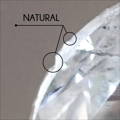
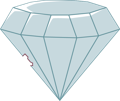
Blemish OR inclusion
Impact on looks: low to medium
Impact on durability: low
Also called: diamond skin
A part of the rough diamond from which the stone was cut, on the surface of a polished diamond. Naturals are usually found on or near the girdle.
This is basically a part of the diamond's original rock. The “skin” of the diamond is more included, often opaque, less smooth and may have growth markings that look like triangles or parallel grooves. You may often see this on the bottom of a cheaper rose cut diamond. This happens when the cutter leaves a small part of the raw diamond crystal on the finished diamond to keep as much carat weight as possible of the diamond.
Indented natural means a part of the rough diamond’s original surface extends into the diamond or dips below the surface. What does this mean for you? This won't be very visible if you have a highly included salt and pepper diamond. If the diamond is set with a closed back, you won't see a thing, and sometimes, it can even mean a sweet deal price-wise.
Impact on looks depends on personal preference and location; it can range from not visible to the naked eye to being a distinctive feature to barely noticeable, especially in highly included diamonds.
Impact on durability is usually not a concern; diamond skin is just on the outside - it’s always been there and not a result of trauma or fracture - so it won’t affect the durability of your diamond.
Needle
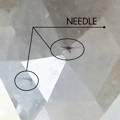

Inclusion
Impact on looks: low
Impact on durability: low
These are like fine lines drawn inside your diamond – subtle and not affecting its strength. They're the kind of imperfections that make you lean in for a closer look.
What does this mean for you? Needles typically don’t affect diamond durability and add a unique internal feature.
Impact on looks is minimal; these inclusions are usually only visible under magnification and add a unique detail to the diamond's inner world.
Impact on durability is hardly a concern; needle inclusions won’t compromise your diamond's structural integrity.
Pinpoint
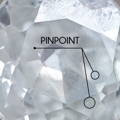
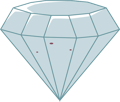
Inclusion
Impact on looks: low
Impact on durability: low
Also called: speck | pepper
As the name suggests, these are tiny specks inside your diamond. Small, inconspicuous, and they don't mess with durability.
Pinpoints are the most common diamond inclusion.
What does this mean for you? Pinpoints are usually not a durability concern and can add to the diamond's uniqueness.
A pit and a pinpoint may look similar, but pits are located on the surface, while pinpoints are incredibly tiny crystals inside the diamond, so small they just look like dots.
Impact on looks is minimal; you can often only spot a pinpoint under magnification.
Impact on durability is low; these tiny inclusions don’t affect the diamond's overall strength.
Scratch


Blemish
Impact on looks: low to medium
Impact on durability: low
Also called: drag line
These are light surface lines that don't dig deep. They're like the minor scratches on your phone screen – there, but not in the way.
A scratch is usually the result of wear and time, but can also be a drag line on the surface, where tiny diamond particles are dragged across the surface by the polishing wheel while cutting the diamond.
What does this mean for you? Scratches are generally superficial and don’t affect the diamond's structural integrity.
Impact on looks is minimal; most scratches are minor and can be minimized or removed with professional polishing.
Impact on durability is not a factor; being surface-level, scratches don’t impact your diamond's overall durability.
diamond imperfections scale chart

Cherish (low impact)
- Bearding: Very small lines around the girdle, a polishing souvenir.
- Cloud: Inclusions resemble a cloud, but it’s actually a cluster of pinpoints within the diamond.
- Crystal: Like a diamond within a diamond.
- Naturals: Part of the diamond skin.
- Needle:A crystal in the form of a long, thin line.
- Pinpoint: A very small crystal that looks like a tiny dot.
- Scratch: Thin mark on the surface.
Pay attention to (medium impact)
- Cavity or Pit: Tiny opening on the surface.
- Chip or Nick: Small dent or other minor surface damage. May affect durability, especially if it’s potentially cracking.
- Feather: Small fracture, crack or break inside of the diamond. Handle with care, especially if it's near the girdle.
Watch out (high impact)
- Cleavage:Straight crack. Red alert - this one's trouble. Best to steer clear.
Included diamonds might not be as tough as the pristine, clear ones, but they're still diamonds. And diamonds, by their very nature, are resilient. They're perfect for everyday wear and for turning into cherished family heirlooms. It's why they're the go-to for wedding and engagement rings.
Like all good things in life, treat your diamond like your best friend. You wouldn't go around knocking your bestie against hard surfaces, right? A little love and care, and your included diamond will be with you for a long, long time.
Related articles:











